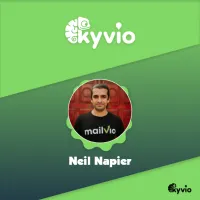Kyvio Blog

How to Write an Email Marketing Copy that Converts?
Email marketing is dead.
Or at least some experts say so. There are plenty of resources on the internet right now, stuffed with expert opinion that email marketing is no longer relevant.
What reasons do they give that make them throw email marketing under the bus?
Evidently, email marketing is the most susceptible to hacker attacks and phishing. The 2020 Verizon Data Breach Investigation report says that every organization receives over 90% of all detected malware through emails.
Email marketing is intrusive. Reportedly, experts at Vice are convinced that the ability to track whether the email was opened and the location where it was opened is a very invasive tactic that ultimately kills this marketing strategy.
Why do email marketing if you have social media? With the rise of social platforms that allow creating more diverse content and reach massive audiences faster, email marketing clearly loses.
These points give a clear explanation, why email marketing might not be the best bet today. So why do so many companies still hang on to it?
No matter what they say, there are also quite a few solid reasons that speak in favor of this marketing strategy.
Proof that Email Marketing is Well and Thriving
While protecting from hacker attacks, malware, phishing, and other threats depends on how well the company tackles its cybersecurity measures, let’s focus more on the difference between email marketing and social media, and why companies around the world still praise email marketing.
Last year, Mail Chimp investigated several email marketing campaigns across different industries to find out the average open rate and click-through rate for every industry.
The research has shown that, among 30+ investigated industries, the average open rate varied between 15.03% and 28.77%, while the click-through rate fluctuated between 1.92% and 4.62.
These numbers are remarkable if you compare them to the performance of social media. According to Campaign Monitor, the average percentage of organic reach on Facebook is 6%, and the click-through rate on Twitter is usually 0.5% on average.
From these results, it’s clear that an average marketing campaign delivers the results that could positively impact the conversion rates. Thus, email marketing is on par with social media marketing, and, in some cases, might even be better.
Of course, all these numbers are achievable in theory. In practice, however, reaching such success requires a lot of time and effort put, first and foremost, in your email marketing copy.
A Guide to Writing an Email Marketing Copy that Converts
Everybody understands that the goal of most email marketing campaigns is to increase sales, which brings along quite a few risks. You cannot write an email copy that’s too salesy because it will end up in spam, and also cannot beat around the bush and should be direct about what your goal is.
So, let’s take a look at what you need to craft a good email marketing copy that’s not too pushy, but effectively helps you increase conversion rates and boost sales.
Step #1: Break Your Target Audience into Segments
In email marketing, the conversion process starts with targeting the right audience, and the narrower the description of your buyer persona is, the better the results of your marketing campaign will be.
However, targeting a very niche audience may not be possible for e-commerce brands that often have a very diverse target audience. For instance, Rue La La is one of such brands, selling clothes for women, men, children as well as home décor products and other merchandise:
Clearly, the brand targets different audiences when it comes to demographics (age and gender) as well as some psychographic indexes, like their needs.
Such a situation creates a dead end because you can’t write an email copy without having a specific audience in mind. In this case, audience segmentation can be an effective solution to this problem.
Audience segmentation means subdividing your target audience into several groups based on one or a few factors. This can be certain psychographic or demographic indexes, product use, etc.
To make their emails more targeted, Rue La La also uses audience segmentation. On the email below, you can see the example of how the company targets its female audience with a specific selection of products:
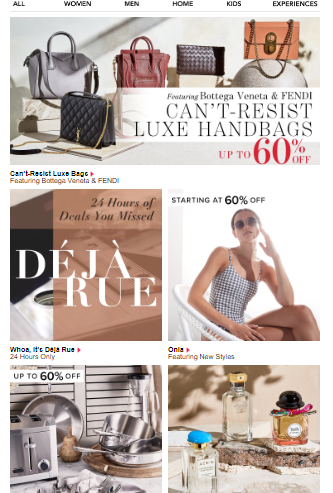
What do you need to segment your audience?
It’s not hard to properly segment your audience if you keep in mind the following three aspects:
Comprehensive email segmentation software. You will save yourself time and money if you choose to segment your audience using special software. For instance, Kyvio’s Smart Mailer solution can help you better understand the demographics of your target audience and create niche segments as a result.
Audience targeting on a page level. Once you’ve segmented your audience using software, you can use these segments to write a more targeted email copy with specific offers for each segment.
Effective lead magnets. After you’ve identified how you want to target each segment, it’s time to come up with lead magnets – special offers that every audience segment will identify itself with. A lead magnet can be based on the customer’s previous orders or offer to solve a particular need.
There are many criteria that you can use to segment your audience, from the demographic factors to their shopping behaviors. Your choice of these criteria will depend on your type of business, your product, and your target audience.
Step #2: Grab Attention with a Subject Line and Preview Text
Now, as you already have your audience segmented, let’s get onto the writing part. And we’ll start with the first things that your customers see in their inbox when they receive your message – the subject line and the preview text.
Writing Good Email Subject Lines
Your email subject line can be a hit or miss when it comes to increasing conversions. Reportedly, 69% of consumers say they report a message as spam based only on an email subject line.
For many consumers, their first experience with your brand starts with reading a subject line of your first email. So, to save it from ending up in the spam folder, let’s take a look at a few good practices that will help you write a good email subject line for your email marketing copy:
Keep your subject line straightforward. Stick to the initial intent of your email and leave out all the filler words. For instance, if the email contains a registration link for an event, it should directly say so in a subject line. Here’s a good example to illustrate this point:
Use emoji if appropriate. Some companies may find it suitable to add emoji to subject lines, as they help their emails stand out in the inbox. Here, it’s important to remember not to overstuff the subject line with emoji and only use those that help emphasize the intent of the subject line and the entire email. Here’s a good example of the correct use of emoji in the subject line from Starbucks:
Don’t write a long subject line. If you want to properly convey the intent of the message in the subject line, 30-40 characters will be enough. Besides, if your subject line is too long, it won’t properly display, even if the customer reads it on the desktop. You might end up with something like this:

Here, it is also important to add that your subject lines, together with the entire email message, should be tested to check how they show up on different devices and email services. In the second example above, you can see that the first emoji doesn’t display properly. To avoid that, make sure that you give your emails a trial run before sending them to your consumers.
Crafting Effective Preview Text
Your preview (or pre-header) text also plays an important role in conversion because it helps build up the customer’s interest in opening your email and taking further action.
Here’s what you need to keep in mind to write an effective preview text:
Capture the most important information. A good pre-header text should contain straightforward details about what the email is about and complement the subject line, like in the example below:

Build suspense. If making a straightforward pre-header text is not the option you’re looking for, then you can choose the creative side and use this space to build suspense and fuel the customer’s appetite for what the email will be about. Here’s a good example of how it can be done:
Make your pre-header text a continuation of the subject line. Another interesting approach you can use to make your preview text more creative is to combine it together with a subject line and turn them into one sentence, like here:
Add a CTA. If you want to increase the open rates of your emails, which is also very important for conversions, make sure your pre-header text also contains a relevant call-to-action. This CTA should also complement the subject line of the email, like on the example below:
On top of the above-mentioned tips, the length of the pre-header text is also important. Make sure that your preview text is no longer than 100 characters and test it to see how it shows on different email services before sending the message.
Step #3: Apply Email Personalization Techniques
Every good marketer knows that to effectively boost sales, it is important to find a personal approach to your customers.
With email marketing, it’s pretty much the same. You need to employ a few personalization techniques to draw more attention to the offer in your email.
What are these techniques?
Let’s take a look.
Address the customer by name. This good old personalization technique still works perfectly. Start your email marketing copy by addressing every customer by name. This will help you establish the connection right away.
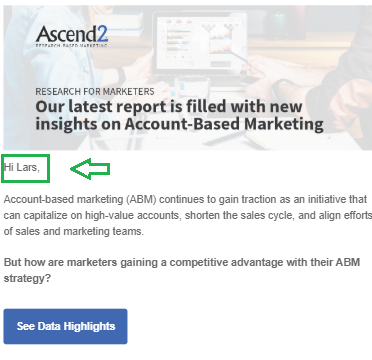
Use behavior triggers for personalized product offers. While you can send specialized product offers based on different audience segments, you can also create personalized offers for a particular customer based on their previous activity and products they purchased. The same personalization approach also works well if you want to reactivate dormant subscribers:
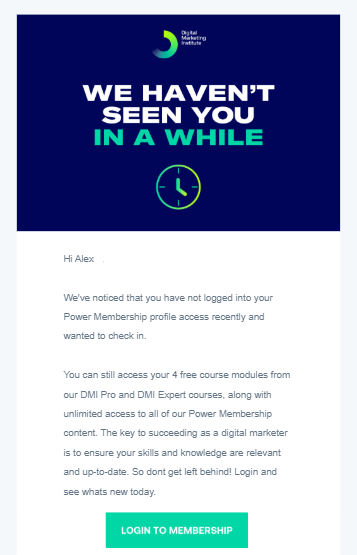
Personalize using your loyalty program. This is another personalization technique beyond addressing your customer by name. A loyalty program already involved personalization because it allows you to build a community that will receive exclusive orders. However, if a consumer is subscribed to your loyalty program, it doesn’t mean that s/he is already your customer. That’s why, to convert them, you can send personalized offers based on the loyalty program to show them the advantages of being your customer.
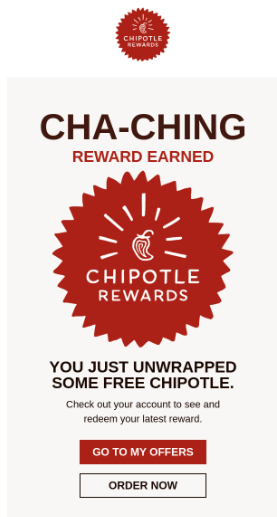
When it comes to writing the text of your personalized email marketing copy, the data from your subscribers decides everything. So, study their behaviors before writing the copy to make sure that you address their needs at the right time.
Step #4: Format Your Text into a Readable Copy
If you want to increase conversion rates using email marketing, you need to make sure that the addressee reads the full email.
Unfortunately, the majority of people have a habit of quickly going through the messages without really reading them, because the message is either too long or incomprehensible.
That’s why you need to incorporate a few readability practices when writing your email marketing copy. To help you better understand what they are, let’s consider the following example.
The Skimm is a media company that sends subscription-based digital newsletters, in which they lay out the most important news to share with their subscribers. Let’s take a look at the newsletter and check out its format:
As you can see, the message starts with a CTA to subscribe to another news outlet from The Skimm to receive more news. The newsletter is subdivided into several sections according to the primary and secondary news of the day. Every section has several subsections, each having a header and being no longer than 100 words.
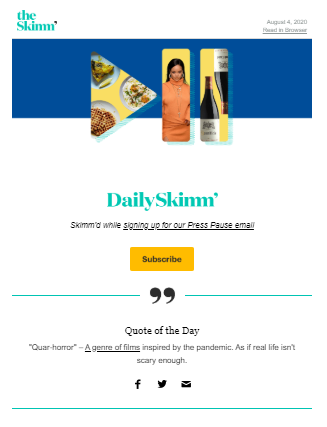
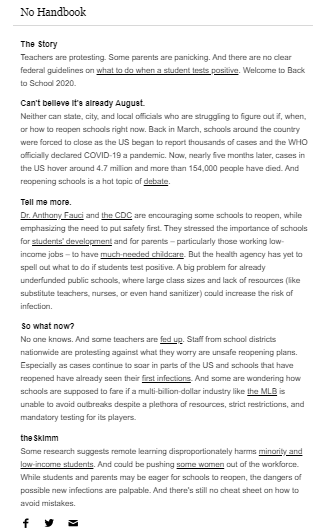
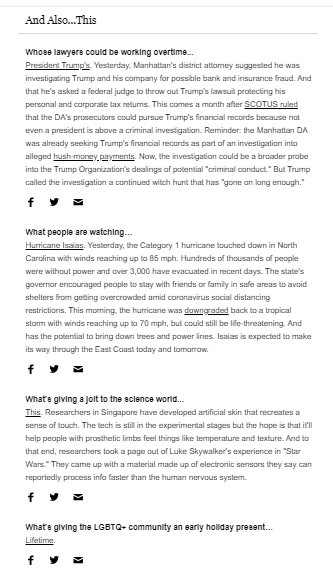
On top of that, every subsection has icons with links by pressing on which a subscriber can share each piece of news from the newsletter on their social media channels.
From this example, we can derive the following good readability practices that you can also employ when writing your email marketing copy:
Use bulleted lists and subheadings. If your email mostly contains text, lists and headers will help you break it down and make it more comprehensible.
Keep paragraphs short. It will be hard for your subscribers to understand your intent if your message is very long and unreadable. So, don’t make your sentences and paragraphs too long. You can also check the readability of your text using a proofreading tool from a reliable writing service to get rid of filler words and confusing constructions.
Use pictures, where you can. A picture can be worth a thousand words. If you don’t want to stuff your email copy with too much text, you can use an infographic or a banner to make your message shorter.
When writing the text for your email, keep the format of the copy in mind. If you want your subscribers to convert, your email copy should show them exactly what they want to see. So, in your message, everything should be in the right place.
Step #5: Close with a Relevant CTA
Finally, your email marketing copy needs something that will inspire further action, that is, invite the addressee to purchase your product, subscribe to your newsletter, or register for an event.
But while adding a CTA button is a given, if your email copy mostly contains text, it should also contain a call-to-action in writing.
Here’s what you need to write a good CTA to boost conversions:
Understand the goal of your CTA. What is the action you would like the addressee to take? First, make sure that it is clear for you, which actions you expect from the addressee, it will help make your CTA more straightforward.
Consider how the addressee can relate to your CTA. What are the needs that the consumer will satisfy or the problems they will solve if they push the CTA button? Answering this question will help you align your expectations with the consumer’s expectations to craft the final CTA.
Choose the appropriate format. Based on the body of your email copy and your intent, you can choose the format for your CTA. Whether it’s a question or an invitation for action, it should be in line with the overall intent of your message.
Here’s a good example of a CTA from the Solo Traveler’s email:
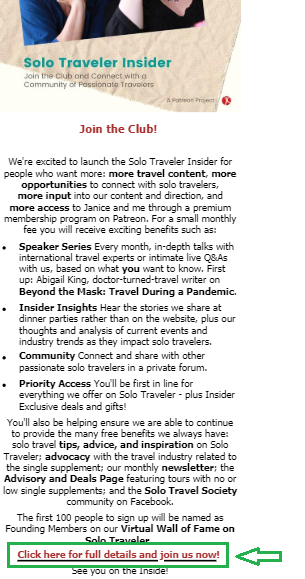
As you can see, this CTA represents the sender’s intent to have more people subscribed to their newsletter, but also effectively uses their curiosity to invite them to check out other details of the subscription process.
The CTA complements the entire message, and the text of the email naturally leads to this CTA. Such an approach of not pushing your offer too hard works far better than stuffing your email with numerous CTA buttons.
Over to You
Indeed, achieving the numbers that we discussed at the beginning of the article is easier said than done. To reach them, you need a well-written email marketing copy that requires a lot of time and effort to develop.
But don’t get discouraged!
This guide will help approach writing your copy more methodically.
By following it step-by-step, you will be able to write the email that properly targets your audience, engages it from the subject line right away, boosts their interest with personalization and proper structure, and, finally, close the deal and convert them into customers with a relevant call-to-action.
Author’s bio. Daniela McVicker is a passionate digital marketer. Daniela is interested in everything related to SEO and blogging. She collaborates with Essayguard and other websites where she shares her experience and helps marketers make their names in the online world.

